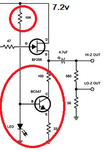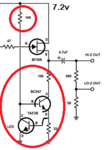neazoi
Advanced Member level 6
Hello,
The RF amplifier design attached uses a simple bc547 and a LED (red circles) as a contant current source for the buffer amplifier FET (am I right?)
How should I measure the constant current at this point in order to replace this circuit with something like this one? **broken link removed**
The RF amplifier design attached uses a simple bc547 and a LED (red circles) as a contant current source for the buffer amplifier FET (am I right?)
How should I measure the constant current at this point in order to replace this circuit with something like this one? **broken link removed**

